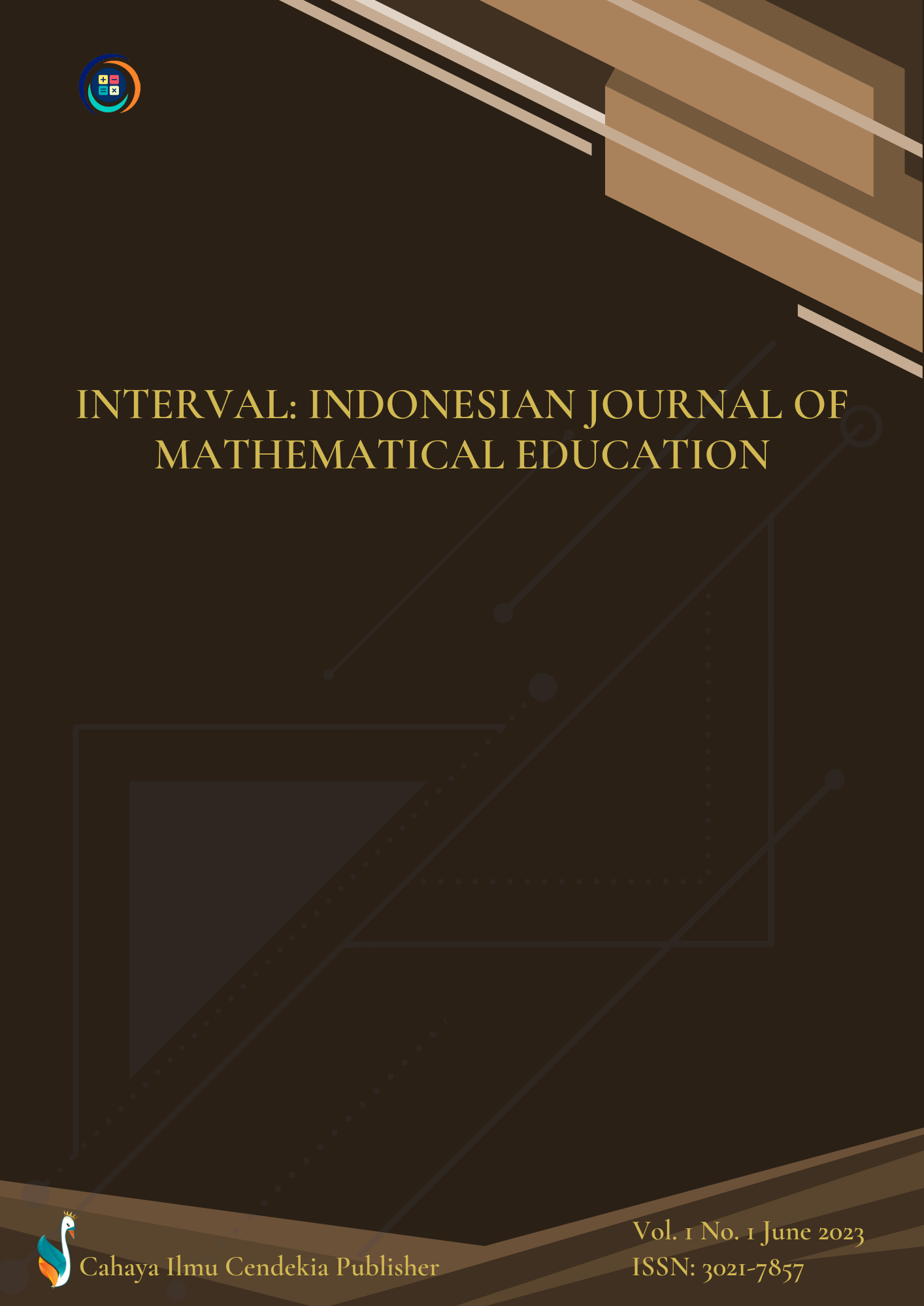Thinking Process of Mathematics Education Students in Problem Solving Proof
Abstract
This type of research is quantitative research. This study used document analysis, interviews and evidence problem solving task instruments. Qualitative data analysis was carried out interactively. The results of this study are the thinking processes of 2nd semester Mathematics Education students who have high learning achievements. Solving the problem of proof in a direct way, contraposition, and contradiction in the entry phase of the thought process activity obtained is the same, that is, the subject understands the problem by writing down the antecedents as what is known and the consequent as what must be proven. The thinking process of 2nd semester Mathematics Education students who have moderate learning achievements. Solving the problem of proof in a direct way, contraposition, and contradiction in the entry phase of the thought process activity obtained is the same, that is, the subject understands the problem by writing down the antecedents as what is known and the consequence as what must be proven. The thinking process of 2nd semester Mathematics Education students who have low learning achievements. Solving the problem of proof in a direct way, contraposition, and contradiction in the entering phase of the thinking process activity obtained is the same, that is, the subject understands the problem by writing down the antecedents as what is known and the consequent as what must be proven
References
I. A. Fitriani, Yani dan Azis, “Literasi Era Revolusi Industi 4.0,” p. 100, 2019.
E. F. Setiya Rini, G. Wibisono, A. Ramadhanti, N. N. Simamora, and D. Chen, “Pengaruh Kemandirian Terhadap Prestasi Belajar Siswa Kelas XI di SMA Negeri 11 Kota Jambi,” J. Pendidik. Fis. dan Teknol., vol. 6, no. 2, p. 256, 2020, doi: 10.29303/jpft.v6i2.2211.
M. Patnani, “Upaya Meningkatkan Kemampuan Problem Solving pada Mahasiswa,” J. Psikogenes., vol. 1, no. 2, pp. 185–198, 2013.
S. Hardiarti, “Etnomatematika: Aplikasi Bangun Datar Segiempat Pada Candi Muaro Jambi,” Aksioma, vol. 8, no. 2, p. 99, 2017, doi: 10.26877/aks.v8i2.1707.
I. Nurfadilah, H. Nindiasari, and A. Fatah, “Problem-Solving Ability Based on Students’ Mathematical,” Prima J. Pendidik. Mat., vol. 5, no. 1, pp. 35–46, 2021.
D. Darmaji, A. Astalini, D. A. Kurniawan, and E. F. Setiya Rini, “Gender Analysis in Measurement Materials: Critical Thinking Ability and Science Processing Skills,” J. Ilm. Pendidik. Fis. Al-BiRuNi, vol. 11, no. 1, pp. 113–128, 2022, doi: 10.24042/jipf.
M. Zein, “Axiology on the Integration of Knowledge, Islam and Science,” Al-Ta lim J., vol. 21, no. 2, pp. 154–160, 2014, doi: 10.15548/jt.v21i2.93.
Astalini et al., “Impact of Science Process Skills on Thinking Skills in Rural and Urban Schools,” Int. J. Instr., vol. 16, no. 2, pp. 803–822, 2023.
E. F. Setiya Rini, R. Fitriani, W. A. Putri, A. A. Br. Ginting, and M. M. Matondang, “Analisis Kerja Keras dalam Mata Pelajaran Fisika di SMAN 1 Kota Jambi,” SAP (Susunan Artik. Pendidikan), vol. 5, no. 3, pp. 221–226, 2021, doi: 10.30998/sap.v5i3.7764.
Tri Pudji Astuti, “Model Problem Based Learning dengan Mind Mapping dalam Pembelajaran IPA Abad 21,” Proceeding Biol. Educ., vol. 3, no. 1, pp. 64–73, 2019, doi: 10.21009/pbe.3-1.9.
D. N. Azizah and S. Zulaikah, “Kemampuan Pemecahan Masalah Siswa melalui Pendekatan Conceptual Problem Solving pada Materi Termodinamika,” no. 2015, pp. 1458–1462, 2018.
R. Ariawan and H. Nufus, “Hubungan Kemampuan Pemecahan Masalah Matematis dengan Kemampuan Komunikasi Matematis Siswa,” J. THEOREMS, vol. 1, no. 2, pp. 82–91, 2017.
M. Suryani, L. Heriyanti, and T. Artia, “Analisis Kemampuan Pemecahan Masalah Siswa Berdasarkan Kemampuan Awal Matematika Mosharafa : Jurnal Pendidikan Matematika Sejalan dengan Permendiknas Nomor Mosharafa : Jurnal Pendidikan Matematika,” Muthofa J. Pendidik. Mat., vol. 9, no. 1, pp. 119–130, 2020.
S. Mawadah and H. Anisah, “Kemampuan Pemecahan Masalah Matematis Siswa pada Pembelajaran Matematika dengan Menggunakan Pembelajaran Generatif di SMP,” EDU-MAT J. Pendidik. Mat., vol. 3, no. 2, pp. 166–175, 2015.
S. Z. Sholihah and E. A. Afriansyah, “Analisis Kesulitan Siswa dalam Proses Pemecahan Masalah Geometri Berdasarkan Tahapan Berpikir Van Hiele,” Mosharafa J. Pendidik. Mat., vol. 6, no. 2, pp. 287–298, 2018, doi: 10.31980/mosharafa.v6i2.317.
Sugiyono, Metode Penelitian dan Pengembangan. Bandung: Alfabeta, 2015.
E. F. Setiya Rini, D. Darmaji, and D. A. Kurniawan, “Identifikasi Kegiatan Praktikum dalam Meningkatkan Keterampilan Proses Sains di SMPN Se-Kecamatan Bajubang,” Edukatif J. Ilmu Pendidik., vol. 4, no. 2, pp. 2476–2481, 2022, doi: 10.31004/edukatif.v4i2.2360.
E. F. S. Rini and F. T. Aldila, “Practicum Activity: Analysis of Science Process Skills and Students ’ Critical Thinking Skills,” Integr. Sci. Educ. J., vol. 4, no. 2, pp. 54–61, 2023, doi: 10.37251/isej.v4i2.322.
M. Y. Lestari and N. Diana, “Keterampilan proses sains (KPS) pada pelaksanaan praktikum Fisika Dasar I,” Indones. J. Sci. Math. Educ., vol. 1, no. 1, pp. 49–54, 2018.
Copyright (c) 2023 Dian Devita Yohanie, Gloria A. Botchway, Alakanani Alex Nkhwalume, Mohammed Arrazaki

This work is licensed under a Creative Commons Attribution-NonCommercial 4.0 International License.
Authors who publish with this journal agree to the following terms:
- Authors retain copyright and acknowledge that the Interval: Indonesian Journal of Mathematical Education is the first publisher licensed under a Creative Commons Attribution 4.0 International License.
- Authors are able to enter into separate, additional contractual arrangements for the non-exclusive distribution of the journal's published version of the work (e.g., post it to an institutional repository or publish it in a book), with an acknowledgment of its initial publication in this journal.
- Authors are permitted and encouraged to post their work online (e.g., in institutional repositories or on their website) prior to and during the submission process, as it can lead to productive exchanges and earlier and greater citation of published work.





.png)
.png)













